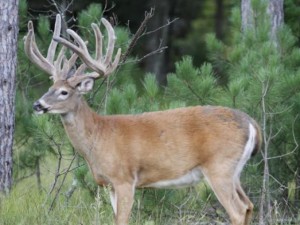 Whitetail antler growth – it’s a driving force for many hunters to seek out the elusive whitetail buck every fall. Male white-tailed deer grow and shed their antlers every year. The last time you saw a buck (or at least knew it was a buck), he probably looked similar to the buck pictured on the left. Usually, bucks begin to shed their antlers in the latter part of the winter, depending on your geographical location.
Whitetail antler growth – it’s a driving force for many hunters to seek out the elusive whitetail buck every fall. Male white-tailed deer grow and shed their antlers every year. The last time you saw a buck (or at least knew it was a buck), he probably looked similar to the buck pictured on the left. Usually, bucks begin to shed their antlers in the latter part of the winter, depending on your geographical location.
Antler growth begins in late March or early April, again depending on geographical location, and the growing bone is covered by skin with numerous blood vessels (velvet). Now is the time to get those trail cameras in the woods. Scouting quality bucks begins in the early spring when antler growth is occurring. Many hunters will wait until their hunting season opens before placing trail cameras and scouting the woods. Those hunters are missing a quality opportunity to increase their chances in having a successful hunt in the fall.
In late summer and early fall, testosterone levels increase. This hormone elevation results in the antlers hardening and the buck rubs off the drying velvet.
Whitetail bucks’ antlers evolved as a weapon system and display mechanism associated with social hierarchy. The size of a buck’s antlers depends on his nutritional intake and age. Any deficiency in dietary energy, protein, calcium, phosphorus or certain vitamins during spring and summer can have strong negative effects. There are only two possible solutions to poor nutrition. One is to reduce deer numbers to more closely match the capacity of the natural habitat. The other is to improve the habitat by cutting, burning, planting or fertilizing to restore the land’s capacity to support healthy deer.
Genetics is another important factor with antler development, but age, nutrition, disease, and injury are often more important contributors to a buck’s antlers than genetics. Without adequate nutrition a buck with the genetic background to become the world record whitetail buck might be less than average.
Age can also effect a buck’s antlers. Whitetailed deer do not achieve maturity until they are 5 to 8 years of age. Studies have demonstrated the average buck achieves only about 10 percent of his potential antler development by age 1.5 years (when he completes his first set of antlers as an 18-month-old buck).
Studies have also demonstrated that there is little relationship between the first year antlers and the antler development a buck will have when he reaches the mature age classes of 5 years or older. This means a spike-antlered buck has a good chance of becoming a trophy quality adult buck. By the time a buck has completed his second set of antlers he still has only achieved 25-35 percent of his potential antler development.
At 3 years of age, a buck still only has achieved about 50 percent of his potential antler quality. It is not until 5 years of age that most bucks approach their full antler potential, and often, antlers don’t reach their maximum size until 7 or 8 years of age (depending on various conditions).
I don’t fault hunters for taking an immature buck for their own specific reason, but as a hunter, I prefer managing the herds allowing bucks to reach their maximum antler growth potential. Whitetail antlers are an amazing example of nature’s wonderful and beautiful handiwork.
#Wired4Backstraps
#Wired4Antlers

